Mobile Marketing Strategy for Ecommerce – Why it Matters & How to Get it Right


Mobile Marketing Strategy for Ecommerce – Why it Matters & How to Get it Right
Get The Print Version
Tired of scrolling? Download a PDF version for easier offline reading and sharing with coworkers.
A link to download the PDF will arrive in your inbox shortly.
You’re more likely to be reading this on your smartphone or mobile device than on desktop. In the past decade, the percentage of web usage on mobile phones has risen dramatically. Since 2018, mobile traffic has represented the majority of global web traffic.
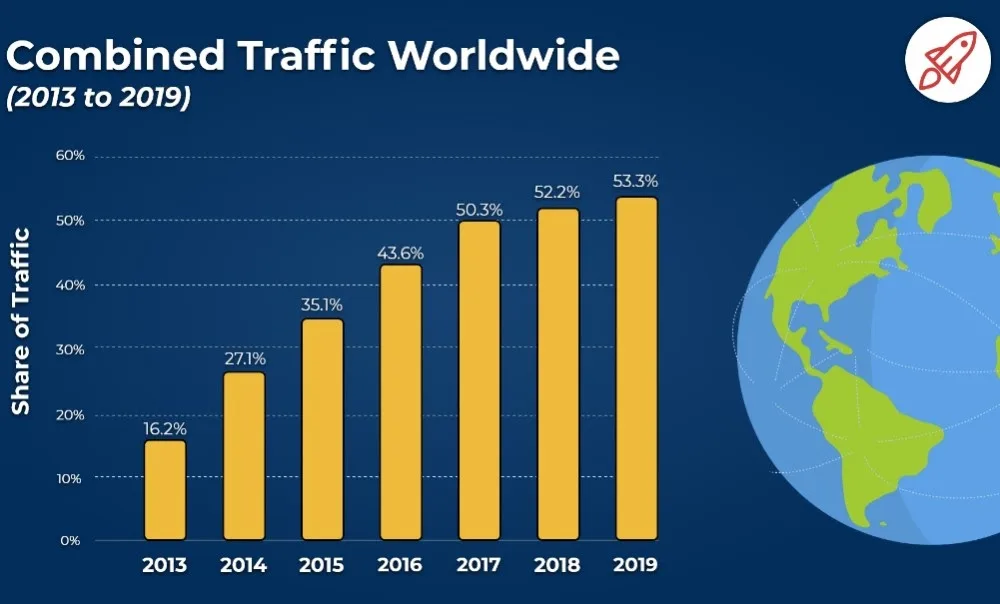
Image Source: broadband search
That’s only mobile phones, too. The figures shown above don’t include traffic from tablets and other mobile devices. That traffic’s also been growing consistently over the same period.
When it comes to modern internet usage, mobile reigns supreme. From teleconferencing to social media and all in between, we rely on smartphones for more than ever before. That’s what makes an effective mobile marketing strategy as precious as gold dust to any business. More than that, mobile campaigns are an absolute necessity in the ecommerce niche.
If you’re not on top of your mobile marketing strategy, it’s time you were. The best place to start is with a grounding in what this type of marketing strategy is, and why it matters. So, let’s start there before moving on to how you can best target mobile users as an ecommerce business and provide a great mobile experience.
What is Mobile Marketing?
The phrase mobile marketing strategy is a broad one. It’s an umbrella term that covers a range of marketing tools, techniques, and processes. What they all have in common is their target audience. At the most basic level, that target audience is mobile users.
Your mobile marketing strategy is how you reach and engage with potential customers while they use their mobile devices. It can – and often should – be a multichannel strategy. You might try to connect by SMS, email, social media, content marketing, via a mobile app, and more.
It’s the ubiquity and popularity of smartphones that makes mobile marketing so vital. On average, people spend three hours and 15 minutes per day on their mobile phones. In online marketing, it always pays to meet your target audience where they are. Increasingly that means connecting with them via mobile.
Mobile Marketing Statistics
As we’ve seen, web usage on mobile devices is higher today than ever before. Desktop users are increasingly in the minority. When you drill down further, you also discover that we now prefer our smartphones for all kinds of activities.
Take using Google or other search engines, for example. Statista found that in the first quarter of 2020, mobile devices accounted for 56% of organic search engine visits. This makes mobile SEO and online marketing essential for small businesses with an online presence.
Opening emails is something else we’re far more likely to do on a smartphone, too. Campaign Monitor research found that 68% of email campaigns now get opened on a mobile device. That’s up on just over 40% in 2015, which in turn was up 30% from the mark in 2010.
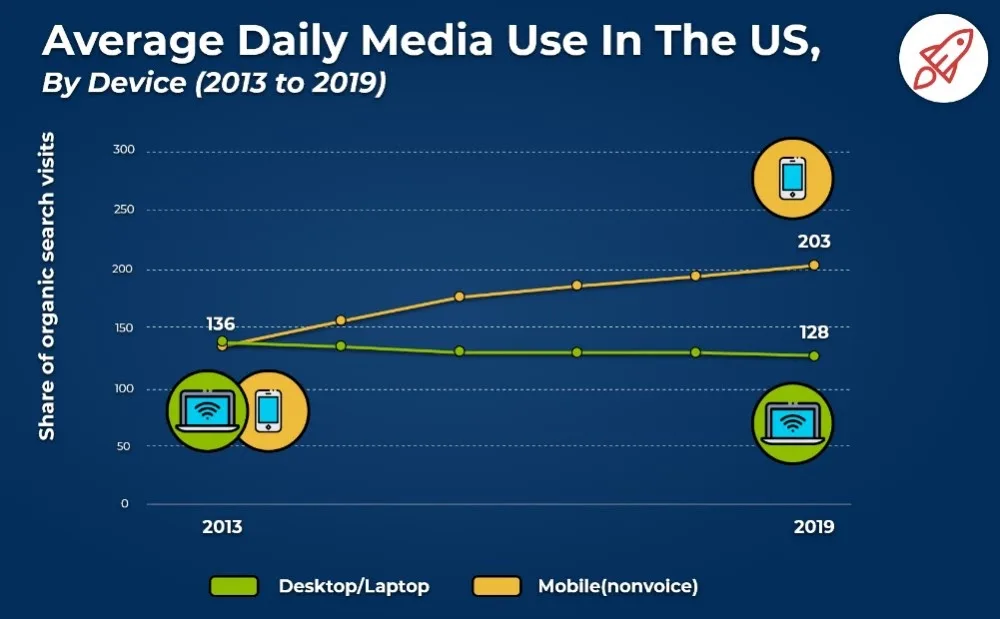
Image Source: broadband search
It’s to our mobile phones we now turn, too, for consuming media. According to Broadband Search, the average person spent 203 minutes consuming media via mobile in 2019. That includes browsing social media platforms, watching videos, and reading ebooks. It compares to only 128 minutes spent on desktop.
What do organic search, email, social media, and video all have in common? They’re vital marketing channels through which companies can engage with leads and turn them into customers. For an ecommerce firm, then, mobile marketing must form a central plank of any digital marketing efforts.
Why Use Mobile Marketing Strategies?
In an increasingly mobile-first world, targeting mobile users is a necessity — particularly for ecommerce businesses. If you don’t actively engage with consumers where they are, you’ll lose ground on your rivals. That’s why it’s important for small businesses as well as larger ones. There are many other compelling reasons to use mobile marketing strategies, too.
1. Easy access.
Unlike some marketing efforts — like SEO or even PPC campaigns via Google Adwords — there’s a low barrier to access for many mobile strategies. Whether you try SMS marketing or a social campaign, you don’t need much technical expertise. Nor do you need any high-level tech. With strong collaboration across your organization, you can get things going with ease.
It’s often more straightforward to track mobile marketing campaigns, too. Easy to understand metrics, such as click-through-rates (CTRs), are useful in measuring success. Platforms like Google Analytics, too, have reports dedicated to mobile users. They help you monitor the mobile optimization of your site and content. That’s as well as offering many other useful insights.
2. Cost effectiveness.
Mobile marketing is a broad church. There are many diverse strategies and processes from which you can choose. That means you can adopt campaigns and channels which suit your budget. You may be surprised at how effective a mobile strategy you can put in place with truly little outlay.
Social media marketing, for instance, is often far cheaper than TV or radio spots. Many mobile marketing strategies, too, can be tightly targeted. Intelligent analytics and research allow you to pinpoint your target audience better. That way, you can focus marketing campaigns on those more likely to convert into customers.
3. Instant transactions.
Mobile is an immediate medium. By reaching out to mobile users, you can engage with people in real-time. That’s whether they’re at home, at work, out and about, or anywhere else besides. Every element of mobile marketing, therefore, is like point of sale (POS) advertising. You’re always reaching people when they’re only a few taps from making a purchase.
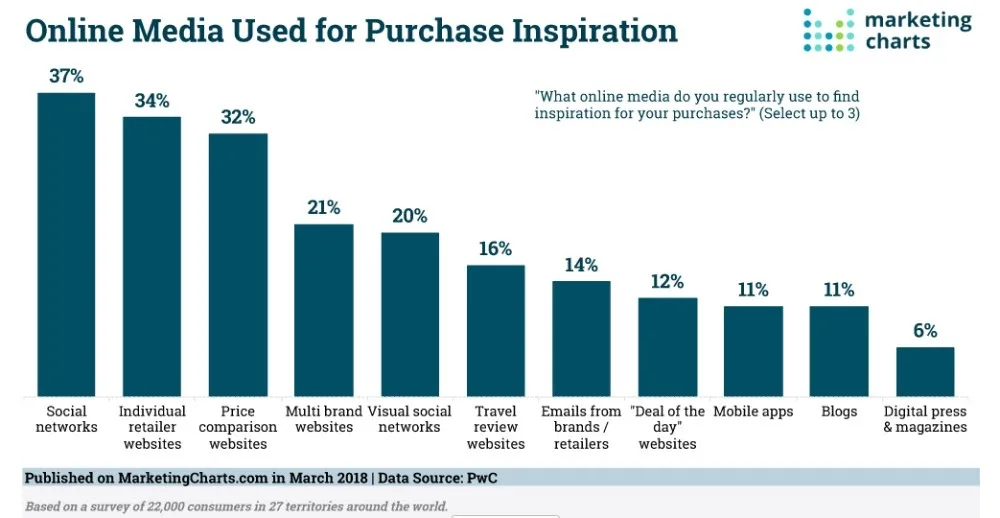
Image Source: Marketing Charts
If designed well, mobile marketing campaigns take advantage of this. You can hit a consumer right when they’re most likely to buy. That may be by placing an ad strategically on social media. It could mean ensuring your mobile site appears on local search listings. However you do it, the instant transactions mobile marketing enables are priceless.
4. Localization.
Most of us take our smartphones wherever we go. It’s a symptom of modern life. That means that via mobile marketing, you can utilize localization. That means presenting content or offers based on the physical context in which prospects find themselves.
Geofencing is one example. That’s where you establish a virtual area surrounded by a barrier or ‘fence.’ When someone with your mobile app goes into the area, they get a particular push notification. Burger King famously geofenced rival restaurants in a marketing campaign that went viral.
Localization, though, is also useful to ecommerce businesses. Not least due to the personalization possible when you have access to location data. With that data on members of your target audience, you can learn more about their habits and needs. That lets you better tailor your mobile SEO and marketing campaigns to suit them.
Challenges that Face Mobile Marketing
So far, we’ve made a compelling case for using mobile marketing strategies. They are, unquestionably, an essential weapon in your digital marketing arsenal. That doesn’t mean, though, that mobile marketing campaigns don’t also have some challenges.
1. User costs.
Certain strands of mobile marketing could see targets of campaigns incur unexpected costs. Say, for instance, that you send a location-based notification or message to a prospect. Your communication might direct them to a marketing video. Perhaps one promoting a product they may wish to buy.
Viewing a video on your mobile phone when you’re out and about takes data. Not everybody has an unlimited data plan. By persuading someone to watch, therefore, you could add to their monthly bill. Whether they’re interested in your product or not, that’s not likely to make a prospect happy.
2. Little room for error.
We’ve already talked about how mobile is an ever-more instant medium. In today’s world, people have short attention spans. That’s great if you can catch their attention and spur immediate action. It’s not so great, though, if the first impression you make is a poor one. With mobile marketing, initial contact is critical.
If your first touchpoint with a potential customer leaves them cold, it’s tough to win them back. That makes it essential to proof and test any content you put out into the digital world. Don’t ever let ads, posts, or anything else besides get out unless they’re perfect.
Take the initial post of a social media campaign promoting a new product line as an example. It takes a piece of compelling content to get someone to stop scrolling and read. All the effort of creating such content gets wasted, though, if you’ve included a broken link or made a similar error. There’s no second chance at a first impression.
Steps for Building a Successful Mobile Marketing Strategy
There are many different mobile marketing strategies that an ecommerce firm can try. We’ll discuss a selection of them a little later. First, though, let’s cover the fundamentals of mobile marketing campaigns. Follow these straightforward steps, and you increase the chances of success. That’s whichever marketing strategy you choose to adopt.
1. Create a mobile buying persona.
As with any marketing campaign, knowing your audience is vital to mobile strategies. You must first define the typical characteristics of your target audience. This is especially important for email campaigns designed to drive more sales where the heart of a sale is going to be based on a more personalized approach.
A buyer persona is a useful tool to help with this. It’s a representation of a typical member of your target audience. Standard buyer personas often include some or all the following information:
Gender
Age
Education
Background
Job
Hobbies & Interests
Goals
Challenges or Pain Points
When thinking about mobile marketing, you can get even more comprehensive. Build information into your persona on how your target audience uses their devices. Which devices do they favor? How long do they spend on their smartphones each day? For which tasks do and don’t they use mobile devices?
There are lots of ways you can get such information for your mobile buyer personas. You might, for instance, survey your existing customers and ask them about smartphone usage. You can also utilize analytics platforms such as Google Analytics.
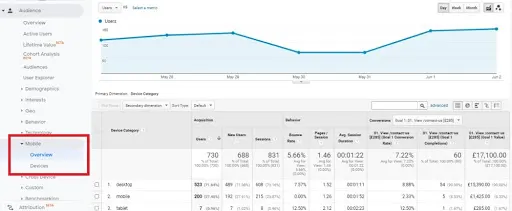
The flagship analytics platform from Google has a whole area devoted to mobile users of any site. As an ecommerce firm, you can gain all sorts of insights into your present mobile customers.
That’s what will help inform your buyer persona. With a persona, it’s easier to laser-focus your mobile marketing strategy on a target audience.
2. Set goals for success.
Once you get rolling with your mobile marketing strategy, you need to track how successful it is. In order to do that, you first need to know what success looks like. It may seem obvious, but many marketers and business owners fail to set goals before implementing new strategies.
Whether you’re managing remote teams or have everyone in-house, bring stakeholders together and discuss all things mobile. Try to get answers to these questions, and ones like them:
What mobile marketing efforts are we currently using? How are these working?
Is our site providing optimized mobile experience?
How can mobile marketing fit with our other campaigns?
Which different mobile marketing strategies are available to us? Which of those will best suit our target audience?
The answers to those questions make it more straightforward to set goals. You can assess which of your current mobile marketing exploits need improvement. You can also pinpoint the new strategies most likely to benefit your business.
From there, you can define clear objectives. For instance, you might have discovered that your site isn’t optimized for mobile devices. Perhaps conversion rates for mobile users are lower than those on desktops. A mobile marketing objective, in that case, might be to bring those rates more in line.
3. Explore mobile marketing options.
You now know what precisely you’re trying to achieve. That puts you in a position to explore your options for doing so. There are a multitude of mobile marketing strategies and alternatives. Not all of them will suit every business.
What you need to do is to look into your available options. When you do, keep in mind both your buyer persona and your objectives. As you explore each option, you must ask whether it suits your target audience as well as if it will help you build toward your goals. If you need inspiration, you’ll find some ecommerce mobile marketing strategies below.
4. Optimize and test.
Staying focused on your target audience and having clear goals gives you the best chance of success. You’re still unlikely to get your mobile marketing strategy perfect, right out of the gate. You need to test your efforts continually, so you can then optimize and improve them.
Depending on your precise strategy, there are a few key things to track to gauge success. Your aim may be to make your site more mobile-friendly, for instance. In that case, watch out for things like the bounce rate of mobile users of your webpages.
You may be looking to target mobile users with an email campaign, meanwhile. Then, it’s open and click-through rates that you need to track. Constantly assessing such metrics lets you tweak your efforts. You can then keep moving ever closer to your goals.
7 Mobile Marketing Strategies for Ecommerce
You should by now, be in no doubt as to the importance of mobile marketing. We’ve also shared some tips on how to build a successful general plan. What’s left is to look at the precise types of strategy best suited to ecommerce firms.
1. Mobile-friendly content.
As an ecommerce business, your webpages are your most vital resource. They’re where you do all your business. One fundamental mobile marketing strategy, then, is to ensure all your content is mobile-friendly. That’s from a simple landing page to your online store’s checkout.
That means ensuring a robust user experience for mobile users. It also means meeting the mobile-friendliness requirements of search engines. For that, your mobile web page’s content must fit well on a smartphone screen. It also needs to load quickly on any device and return no mobile-specific errors. All in all, you’re looking for a responsive design which best showcases your products.
2. Voice search optimization.
We’re all far more used to speaking into our smartphones than to our laptops. Think phone calls, talking to virtual assistants, and video conferences. So many of us have been using Zoom alternatives for that, of late. One way or another, we’re always chatting away with our devices. Voice search, therefore, is a growing trend.
More people are going to start searching by voice rather than typing search phrases — particularly mobile web users. You can get a jump on your rivals by optimizing your webpages for voice search.
That takes some more mobile-specific keyword research. You need to find those long-tail phrases that people might actually say into their phones. That might be things like ‘where can I buy the best sneakers?’, for instance. Some prevalent mobile search time might never get typed by desktop users.
3. Text message marketing.
When we talk about modern phones, it’s tempting to think only about internet connectivity. They do, however, still enable communication in more traditional ways. Text messaging is a prime example. It’s also an excellent marketing channel for ecommerce businesses to explore.
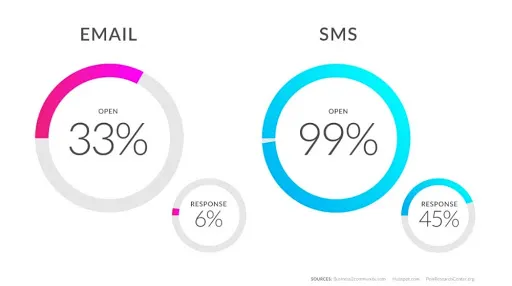
Image Source: Timely
The open rate for text messages is phenomenally high. Think about it; how often do you leave an SMS unopened? Response rates for marketing texts, too, far outstrip those for email marketing. If you’re able to reach out to people via text, you should. It’s as simple as that.
Connecting with someone by text is personal. It’s a communication channel many people still think of as being for interacting with loved ones. Make that work to your advantage, not your detriment. Keep marketing texts short and personalized, and ensure to offer recipients something of genuine value.
With this in mind and with the use of clever copywriting, then text message marketing can become an extremely profitable form of mobile marketing for you.
4. Videos.
Mobile users consume video content at a prodigious rate. Marketing videos, too, are highly effective at influencing purchase decisions. People retain the information they consume via video. What’s more, 85% of millennials say they’ve bought a product after watching a marketing video.
There are loads of options for using video as part of a mobile marketing strategy. YouTube ads or product explainer clips on your website are prominent examples. Videos, though, are also a great way to engage with your audience via social media.

Image Source: Instagram
The beauty brand Bliss has a great video content marketing strategy on Instagram. The brand’s IGTV feed is full of engaging clips that their target audience is sure to love. Sharing such material is a great way to build customer loyalty and a sense of brand community.
5. Personalized campaigns.
Personalization is huge in modern digital marketing. Marketers and businesses have realized consumers don’t like to get treated like a number. Firms that engage on a personal level make lasting connections with customers.
There are many ways you can use mobile marketing to deliver personalized campaigns. Whether you reach out by SMS, email, or social media, try to make customers feel like you’re speaking to only them.
You could, for instance, run a mobile-friendly email marketing campaign. By tracking a mobile user’s activity on your site, you could send a personalized product recommendations message. That’s the kind of content that fosters a superior user experience.
6. Mobile apps.
If you’re genuinely motivated about mobile marketing, you might want to develop your own mobile app. There are lots of ways to support your ecommerce efforts with an app that customers can download.

Image Source: Facebook
Home and furniture specialists, Burrow, took a humorous approach. They built an app called ‘Couch Potato,’ which the company branded as an ‘inactivity tracker.’ Tongues firmly in cheek, the brand was promoting how enjoyable it is to sit back and relax on their furniture.
Such apps can make a real impact on consumers. Burrow’s offering was so innovative and fun that it got lots of news coverage. Brand recognition got raised with those who read about, as well as used the app, therefore. When they next needed a sofa, more of those people may have considered Burrow as an ecommerce destination.
7. Search and display ads.
Search and display ads can each also play a vital part in your mobile marketing strategy. The important thing here is to know when and how to utilize each. Both versions of ads have their strengths and weaknesses.
Display ads — such as banners or pop-ups, for instance — are excellent for brand awareness. They show off your brand and your products in places where you’re likely to find potential customers. For example, a reader of an interior design blog might see a banner ad for a home furnishings retailer.
Search ads, like from Google Ads, meanwhile, play a different role. They’re your pay-per-click (PPC) ads and are superb for targeting specific audiences. A robust mobile PPC campaign boosts webpage traffic and conversion rates. That’s because the keywords that people are searching for tell you that they’re already interested in your products.
Wrapping Up Mobile Marketing
The ecommerce market has never been larger than it is today. Online shopping is forever growing in popularity. The number of brands looking to meet that demand, though, is also ever-expanding. As an online retailer, you need to take every opportunity to get an edge on your rivals.
A robust and effective mobile marketing strategy is no longer optional. It’s a necessity. You must engage with consumers where they are, and increasingly they’re on mobile devices. Fortunately, it’s easier to make mobile marketing work in your favor than you may think.
There are a multitude of mobile marketing strategies that can deliver outstanding results. From optimizing your site content for smartphones to building a unique app, your options are almost limitless.
So, what are you waiting for? Inventory your current campaigns, talk to stakeholders, and supercharge your mobile marketing strategy. You can be sure that’s what your competitors are doing.

John Allen, Director, Global SEO at RingCentral, a global UCaaS, VoIP and video conferencing solutions provider. He has over 14 years of experience and an extensive background in building and optimizing digital marketing programs. He has written for websites such as Hubspot and Toolbox.


